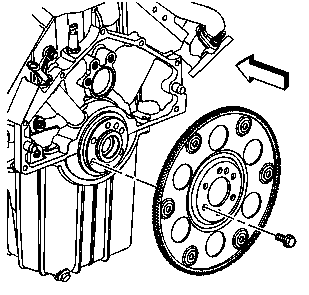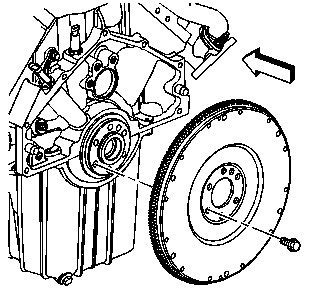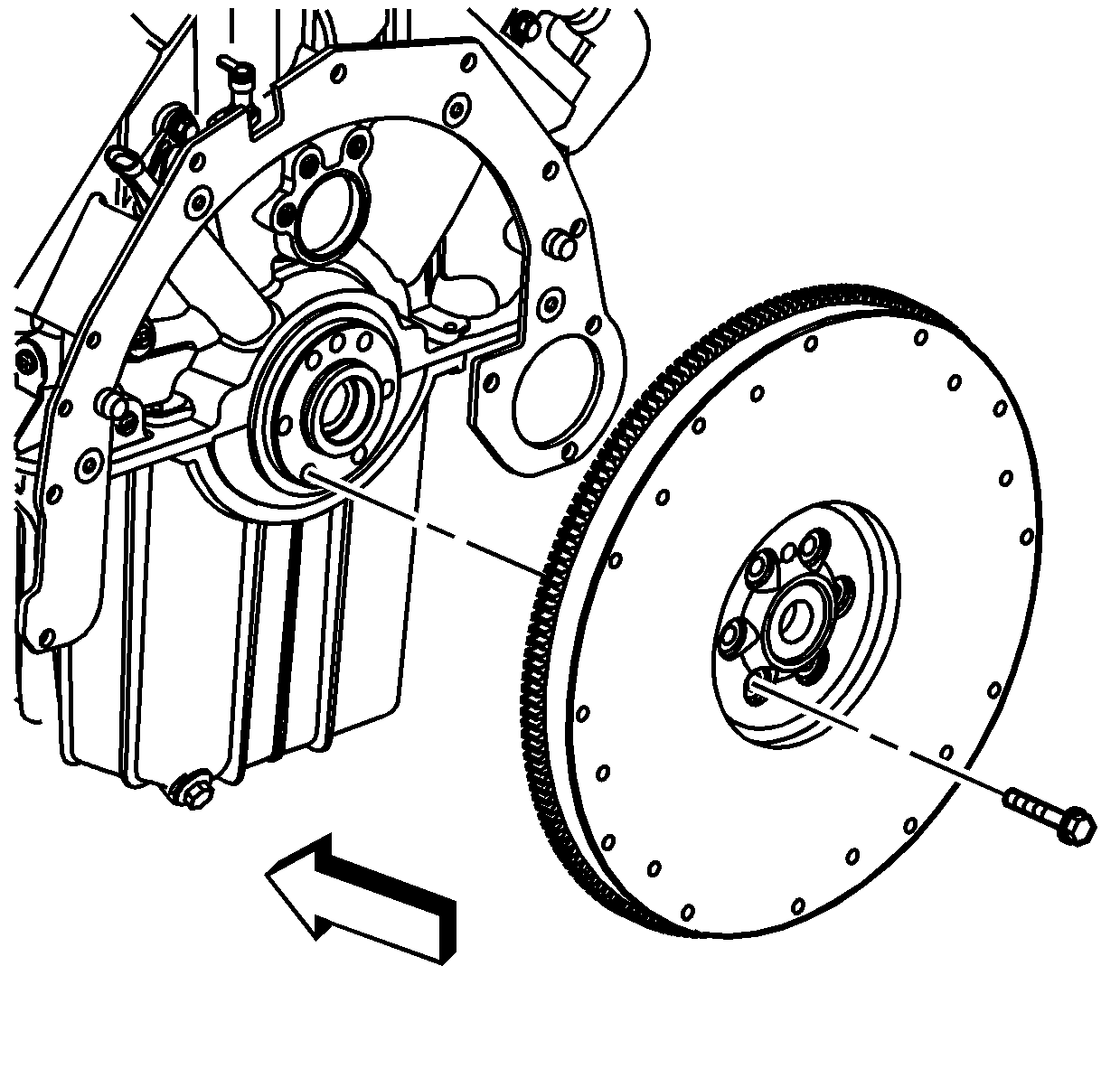Engine Flywheel Installation C/K/G/C3500HD with AT
- Install the engine flywheel.
- Install the engine flywheel bolts.

Important: Make sure the flywheel is installed correctly. Engine Side is stamped on the flywheel to assist with installation.
Notice: Use the correct fastener in the correct location. Replacement fasteners must be the correct part number for that application. Fasteners requiring replacement or fasteners requiring the use of thread locking compound or sealant are identified in the service procedure. Do not use paints, lubricants, or corrosion inhibitors on fasteners or fastener joint surfaces unless specified. These coatings affect fastener torque and joint clamping force and may damage the fastener. Use the correct tightening sequence and specifications when installing fasteners in order to avoid damage to parts and systems.
Tighten
| • | Tighten the engine flywheel bolts to 40 N·m (30 lb ft) for the first pass. |
| • | Tighten the engine flywheel bolts to 80 N·m (59 lb ft) for the second pass. |
| • | Tighten the engine flywheel bolts to 100 N·m (74 lb ft) for the final pass. |
Engine Flywheel Installation C/K with MT
- Install the engine flywheel.
- Install the engine flywheel bolts.

Notice: Use the correct fastener in the correct location. Replacement fasteners must be the correct part number for that application. Fasteners requiring replacement or fasteners requiring the use of thread locking compound or sealant are identified in the service procedure. Do not use paints, lubricants, or corrosion inhibitors on fasteners or fastener joint surfaces unless specified. These coatings affect fastener torque and joint clamping force and may damage the fastener. Use the correct tightening sequence and specifications when installing fasteners in order to avoid damage to parts and systems.
Tighten the fasteners following a criss cross pattern.
Tighten
| • | Tighten the engine flywheel bolts to 40 N·m (30 lb ft) for the first pass. |
| • | Tighten the engine flywheel bolts to 80 N·m (59 lb ft) for the second pass. |
| • | Tighten the engine flywheel bolts to 100 N·m (74 lb ft) for the final pass. |
Engine Flywheel Installation Medium Duty with AT
- Install the engine flywheel.
- Install the engine flywheel bolts.

Important: Make sure the flywheel is installed correctly. Engine Side is stamped on the flywheel to assist with installation.
Notice: Use the correct fastener in the correct location. Replacement fasteners must be the correct part number for that application. Fasteners requiring replacement or fasteners requiring the use of thread locking compound or sealant are identified in the service procedure. Do not use paints, lubricants, or corrosion inhibitors on fasteners or fastener joint surfaces unless specified. These coatings affect fastener torque and joint clamping force and may damage the fastener. Use the correct tightening sequence and specifications when installing fasteners in order to avoid damage to parts and systems.
Tighten the fasteners following a criss cross pattern.
Tighten
| • | Tighten the engine flywheel bolts to 40 N·m (30 lb ft) for the first pass. |
| • | Tighten the engine flywheel bolts to 80 N·m (59 lb ft) for the second pass. |
| • | Tighten the engine flywheel bolts to 100 N·m (74 lb ft) for the final pass. |
Engine Flywheel Installation Medium Duty with MT
- Install the engine flywheel.
- Install the engine flywheel bolts.

Notice: Use the correct fastener in the correct location. Replacement fasteners must be the correct part number for that application. Fasteners requiring replacement or fasteners requiring the use of thread locking compound or sealant are identified in the service procedure. Do not use paints, lubricants, or corrosion inhibitors on fasteners or fastener joint surfaces unless specified. These coatings affect fastener torque and joint clamping force and may damage the fastener. Use the correct tightening sequence and specifications when installing fasteners in order to avoid damage to parts and systems.
Tighten the fasteners following a criss cross pattern.
Tighten
| • | Tighten the engine flywheel bolts to 40 N·m (30 lb ft) for the first pass. |
| • | Tighten the engine flywheel bolts to 80 N·m (59 lb ft) for the second pass. |
| • | Tighten the engine flywheel bolts to 100 N·m (74 lb ft) for the final pass. |
